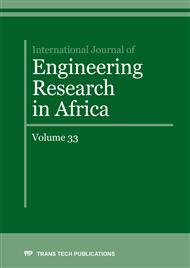[1]
Shene C., A. Leyton, Y. Esparza, L. Flores, B. Quilodrán, I. Hinzpeter and M. Rubilar. 2010. Microbial oils and fatty acids: effect of carbon source on docosahexaenoic acid (22: 6n-3, DHA) production by thraustochytrid strains. J. Soil Sci. Plant Nutri. 10: 2017-216.
DOI: 10.4067/s0718-95162010000100002
Google Scholar
[2]
Bongiorni L., A. Pusceddu and R. Danovaro. 2005. Enzymatic activities of epiphytic and benthic thraustochytrids involved in organic matter degradation. Aquat. Microb. Ecol. 41: 299-305.
DOI: 10.3354/ame041299
Google Scholar
[3]
Hong WK., C.H. Kim, D. Rairakhwada, S. Kim, B.K. Hur, A. Kondo and J.W. Seo. 2012. Growth of the oleaginous microalga Aurantochytrium sp. KRS101 on cellulosic biomass and the production of lipids containing high levels of docasahexaenoic acid. Bioprocess Biosys. Eng. 35: 129-133.
DOI: 10.1007/s00449-011-0605-0
Google Scholar
[4]
Gupta, A., CJ Barrow and M. Puri. 2012. Omega-3 biotechnology: thraustochytrids as a novel source of omega-3 oils. Biotechnol. Adv. 30: 1733-45.
DOI: 10.1016/j.biotechadv.2012.02.014
Google Scholar
[5]
Haber B. 2004. Generally Recognized As Safe (GRAS) of DHA –Rich Oil for use as a food ingredient to provide a dietary source of ω- polyunsaturated fatty acids. Federal Food, Drug, and Cosmetic Act (FDA).
Google Scholar
[6]
Cunnane, SC. 2003. Problems with essential fatty acids: time for a new paradigm? Prog Lipid Res. 42: 544-68.
DOI: 10.1016/s0163-7827(03)00038-9
Google Scholar
[7]
Simopoulos, AP. 2010. Genetic variants in the metabolism of omega-6 and omega-3 fatty acids: their role in the determination of nutritional requirements and chronic disease risk. Exp Biol Med (Maywood) 235: 785-95.
DOI: 10.1258/ebm.2010.009298
Google Scholar
[8]
Serhan, CN., Chiang N. 2008. Endogenous pro-resolving and anti-inflammatory lipid mediators: a new pharmacologic genus. Br J Pharmacol 153 Suppl 1: S200-15.
DOI: 10.1038/sj.bjp.0707489
Google Scholar
[9]
Calder, PC. 2006. n-3 Polyunsaturated fatty acid, inflammation, and inflammatory disease. Am J Clin Nutr 83(suppl 6): 1505S-19S.
Google Scholar
[10]
Wanten, GJ., Calder, PC. 2007. Immune modulation by parenteral lipid emulsions. Am J Clin Nutr 85: 1171-84.
Google Scholar
[11]
Silva, D., A. Roa, R. Quevedo and B. Quilodrán. 2015. Production of biodiesel from soybean frying oil using native strains of Thraustochytrids. Chilean J. Agric. Anim. Sci., ex Agro-Ciencia 31(1): 29-41.
Google Scholar
[12]
Hinzpeter, I. B. Quilodrán, E. Hormazabal, A. Quiroz and C. Shene. 2010. Isolation of thraustochytrid strains in the coastal zone of Puerto Montt, Chile and evaluation of Docosahexaenoic acid (22: 6n-3, DHA) production. Afinidad 66: 482-87. [In Spanish].
DOI: 10.1007/s11274-009-0115-2
Google Scholar
[13]
Lewis, TE., Nichols, PD. and McMeekin, TA. 1999. The biotechnological potential of Thraustochytrids. Mar Biotechnol 1: 580-87.
DOI: 10.1007/pl00011813
Google Scholar
[14]
Quilodrán, B., I. Hinzpeter, E. Hormazabal, A. Quiroz and C. Shene. 2010. Docosahexaenoic acid (C22: 6 n3, DHA) and astaxanthin production by Thraustochytriidae sp. AS4-A1 a native strain with high similitude to Ulkenia sp.: evaluation of liquid residues from food industry as nutrient sources. Enzyme Microb Technol 47: 24-30.
DOI: 10.1016/j.enzmictec.2010.04.002
Google Scholar
[15]
Armenta. RE. and Mercia C. Valentine. 2013. Single Cells Oils as a source of Omega-3 Fatty Acids: An overview of recent advances. J Am Oil Chem Soc 90: 167-182.
DOI: 10.1007/s11746-012-2154-3
Google Scholar
[16]
Raghukumar, S. 2008. Thraustochytrid Marine Protists: Production of PUFAs and Other Emerging Technologies. Mar Biotechnol 10: 631-640.
DOI: 10.1007/s10126-008-9135-4
Google Scholar
[17]
Liang, Y., N. Sarkany, Y. Cui, J. Yesuf, J. Trushensky and J. W. Blackburn. 2010. Use of sweet sorghum juice for lipid production by Schizochytrium limacinum SR21. Bioresource Technology 101: 3623-27.
DOI: 10.1016/j.biortech.2009.12.087
Google Scholar
[18]
Pyle, D.J., R.A. García and Z. Wen. 2008. Producing docosahexaenoic acid (DHA)-rich algae from biodiesel-derived crude glycerol: effects of impurities on DHA production and algal biomass composition. J Agric Food Chem. 56: 3933-39.
DOI: 10.1021/jf800602s
Google Scholar


